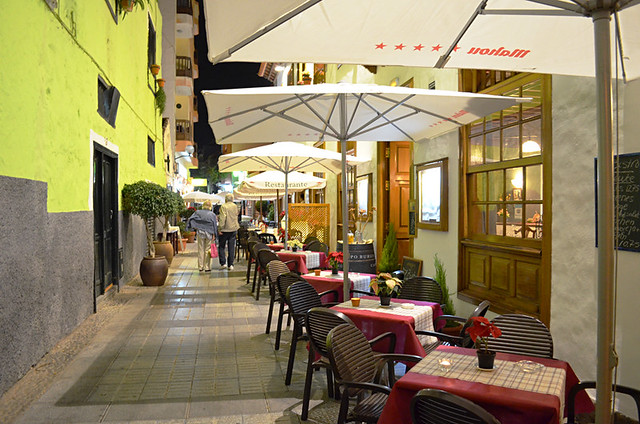In December 2003 we trawled my family around restaurants in Puerto de la Cruz looking for a menu which would suit the differing tastes of three generations.
“All these menus are exactly the same,” remarked my brother in law at one point.

He was absolutely right. We’d only been on the island two months and were still basking in exploring gastronomy which was completely new to us. Because everything was shiny and new we hadn’t noticed menus in traditional restaurants were almost identical. It was obvious really, you find the same thing in many places.
The culinary scene has evolved remarkably since then, with talented young chefs and their contemporary takes on traditional dishes placing Tenerife firmly on the world map as far as good food is concerned. I’d go as far as to say the island now has a gastronomic scene which is as good if not better than many locations around Europe renowned for their food. Italy clearly remaining top perro.

Although there are modern Canarian restaurants in most bigger historic towns, traditional Canarian nosh still dominates across the island; subsequently their menus are now like familiar old friends. So much so, it’s easy to forget that not everyone who visits the island knows exactly what the most popular Canarian dishes are, especially if dining experiences revolve mainly around restaurants in purpose built resorts.
For anyone interested in munching their way through a meal with a completely local flavour, these are our suggestions of distinctly Canarian dishes to order.
Appetiser

If the restaurant is authentically Canarian you should find a basket of bread accompanied by alioli (garlic mayonnaise) plonked in front of you. If there’s almogrote (a strong cheese pate from La Gomera) on the menu, order some to get the meal off to a strong start.
To drink

It has to be local wine. We’re red wine drinkers and have it whether eating meat or fish. If there’s Balcón Canario we’d go for that, but it’s not common on menus. More often than not we’ll choose one of the Bodega Monje range, or just ask the waiter for recommendations. For beer drinkers, Dorada is the island’s main lager, but if there’s any local craft ale to be had (e.g. Tacoa’s beers or Tierra de Perros) they’re in a different taste league altogether.
Entrantes y sopas (starters and soups)

Many starters on traditional menus are no strangers to the average Spanish menu. To stick to Canarian cuisine you need to opt for something that’s more of a speciality in the islands. Our neighbour always ordered the same thing when we ate together in a trad restaurant, queso asado, griddled cheese drizzled with mojo verde, mojo rojo (green and red Canarian salsas) and often honey. The salsas are essential as the cheese on its own can be quite bland. Alternatively, if you prefer soup to start, try potaje de berros (watercress soup).

If really hungry go for huevos al estampido which is often found on the tapas or ‘para picar’ section of menus. It’s basically egg, chips and a chorizo sauce. I recently saw a Spanish food programme where the presenter asked for a local dish to try in a guachinche. His face was a picture when the owner dished him up a plate of egg and chips. Seafood fans have a few choices to get the juices flowing, lapas (limpets drizzled with wine, garlic olive oil and herbs) look and taste great.
Carnes (meat main courses)

On Canarian menus you find the usual range of steaks, pork, chicken etc. Grilled meats are a big thing on the island. But to truly go local it’s worth trying conejo en salmorejo (rabbit in a savoury sauce) or cabra (goat) which are very popular specialities. I’m a big fan of both. I’m not a fan of Costillas con papas y piña de millo (ribs with potatoes, corn and lots of other things), it’s too much of a mess of a dish and the meat looks like it’s sickly, but it is authentically Canarian.
Pescados (fish main courses)

For obvious reasons, there’s loads to choose from on the fish and seafood sections of traditional menus. Vieja (parrotfish) is one of the island favourites but even more common is cherne (wreckfish/stone bass), a tasty fish with chunky, white flesh. It’s also good value, or it should be. I’m sure some resort restaurants try to pass it off as more exotic than it is, charging double the price of its value. I know restaurants in the south with basic cherne dishes on their menus at a whopping €20+.
Whether fish or meat, it’s got to be accompanied by papas arrugadas and mojos (salty, wrinkled potatoes with spicy salsas) for the full Canarian dining experience.
Postres (desserts)

In my view, traditional desserts aren’t Canarian cuisine’s strongest point, being largely based on milk, milk, and milk. But some stand out from the crowd. Bienmesabe can be hit and miss, sometimes sticky and stodgy. But when done well, this blend of almonds, egg yolks, cinnamon, lemon rind, sugar, water, and crushed biscuits is pretty good. Leche asada is roasted milk, which doesn’t conjure a particularly mouthwatering image even though a good one can really get the taste-buds excited. Ingredients are milk, eggs, cinnamon, condensed milk, lemon rind, butter, and palm honey.
A chupito to finish

Everyone knows this – it has to be a shot of ron miel (honey rum).
Buen provecho.




Be the first to comment